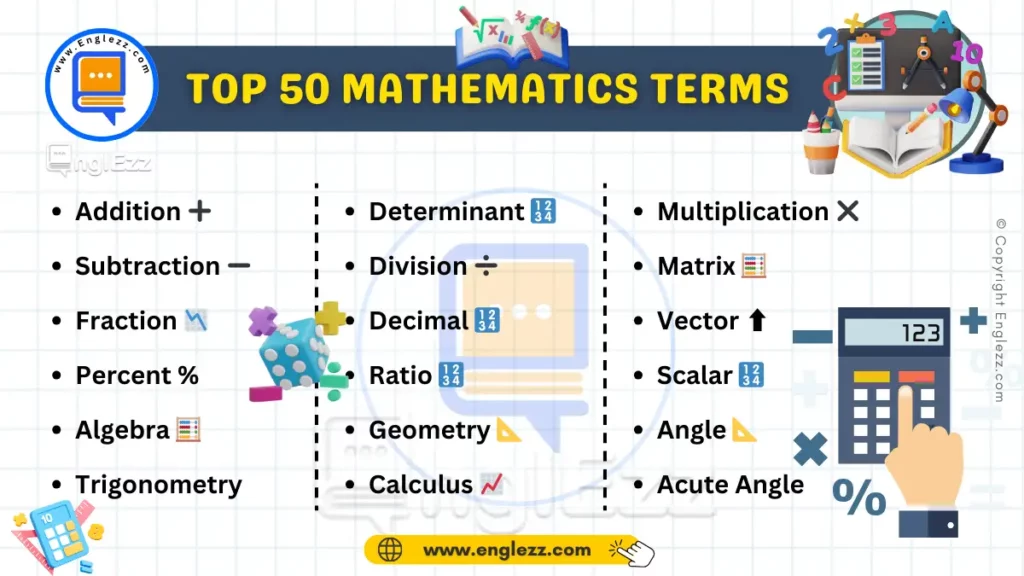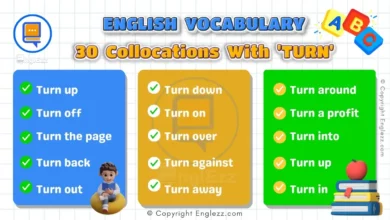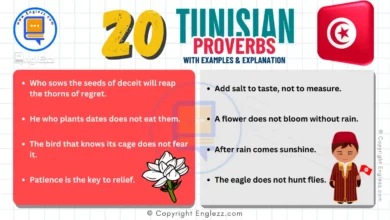Mathematics can often seem like a complex language of its own, filled with terms and jargon that might confuse even the most seasoned learners. Understanding these mathematical terms is crucial for students, professionals, and enthusiasts alike to grasp the fundamental concepts and apply them effectively. In this blog post, we will delve into 50 of the most common mathematics English terms, providing clear definitions, phonetic transcriptions, and practical examples to illustrate each term.
Table of Contents
- 50 Most Common Mathematics English Terms Explained with Examples
- #1. Addition ➕
- #2. Subtraction ➖
- #3. Multiplication ✖️
- #4. Division ➗
- #5. Fraction 📉
- #6. Decimal 🔢
- #7. Percent %
- #8. Ratio 🔢
- #9. Proportion 📊
- #10. Algebra 🧮
- #11. Geometry 📐
- #12. Trigonometry 📏
- #13. Calculus 📈
- #14. Theorem 📜
- #15. Function 🔍
- #16. Variable 🔄
- #17. Constant 📏
- #18. Exponent 📐
- #19. Logarithm 🔎
- #20. Matrix 🧮
- #21. Determinant 🔢
- #22. Vector ⬆️
- #23. Scalar 🔢
- #24. Angle 📐
- #25. Acute Angle 🔺
- #26. Obtuse Angle 🔻
- #27. Right Angle 🔲
- #28. Supplementary Angles 🏛️
- #29. Complementary Angles 🧩
- #30. Polygon 🔶
- #31. Triangle 🔺
- #32. Quadrilateral 🔳
- #33. Circle 🔵
- #34. Radius 🔴
- #35. Diameter 🟠
- #36. Circumference 🔵
- #37. Area 📏
- #38. Volume 📦
- #39. Perimeter 📐
- #40. Coordinate Plane 🗺️
- #41. Origin ⚓
- #42. Line Segment ➖
- #43. Ray 🌟
- #44. Angle Bisector ✂️
- #45. Parallel Lines 🔄
- #46. Perpendicular Lines ⏹️
- #47. Intersection 🔗
- #48. Union 🔗
- #49. Intersection of Sets 🧩
- #50. Set Theory 📚
- Most Common Mathematics English Terms
- Conclusion
50 Most Common Mathematics English Terms Explained with Examples
Whether you’re a student striving for a better understanding of your math lessons or a teacher looking for a reference guide, this comprehensive list will serve as an invaluable resource. By breaking down these terms into manageable explanations and relatable examples, we aim to make mathematics more accessible and less intimidating.
Let’s explore these essential terms to enhance your mathematical vocabulary and confidence.
#1. Addition ➕
Definition: The process of finding the total or sum by combining two or more numbers. Phonetic Transcription: /əˈdɪʃən/ Examples:
- Adding 5 and 3 gives you a sum of 8. (5 + 3 = 8)
- The total cost of three items priced at $10, $15, and $20 is $45. (10 + 15 + 20 = 45)
#2. Subtraction ➖
Definition: The operation of finding the difference between two numbers by taking one number away from another. Phonetic Transcription: /səbˈtrækʃən/ Examples:
- Subtracting 4 from 10 leaves you with 6. (10 – 4 = 6)
- If you have $20 and spend $7, you have $13 left. (20 – 7 = 13)
#3. Multiplication ✖️
Definition: The process of finding the total of one number repeated a certain number of times. Phonetic Transcription: /ˌmʌltɪplɪˈkeɪʃən/ Examples:
- Multiplying 4 by 3 gives you 12. (4 × 3 = 12)
- If each of the 5 students has 2 pencils, there are 10 pencils in total. (5 × 2 = 10)
#4. Division ➗
Definition: The process of splitting a number into equal parts. Phonetic Transcription: /dɪˈvɪʒən/ Examples:
- Dividing 12 by 3 gives you 4. (12 ÷ 3 = 4)
- If you share 24 cookies among 8 friends, each friend gets 3 cookies. (24 ÷ 8 = 3)
#5. Fraction 📉
Definition: A number that represents a part of a whole, expressed as one integer divided by another. Phonetic Transcription: /ˈfrækʃən/ Examples:
- 1/2 represents half of a whole. (e.g., one slice out of two equal slices of a pizza)
- 3/4 means three parts of a whole divided into four equal parts. (e.g., three quarters of a cup of milk)
#6. Decimal 🔢
Definition: A number that includes a decimal point, separating the integer part from the fractional part. Phonetic Transcription: /ˈdɛsɪməl/ Examples:
- 0.75 represents seventy-five hundredths. (e.g., three-quarters of a dollar)
- 2.5 means two and a half. (e.g., 2.5 liters of water)
#7. Percent %
Definition: A ratio expressed as a fraction of 100. Phonetic Transcription: /pərˈsɛnt/ Examples:
- 50% is half of a whole. (e.g., 50% off a $20 item means it costs $10)
- 25% means one-quarter of a whole. (e.g., 25% of a class of 40 students is 10 students)
#8. Ratio 🔢
Definition: A relationship between two numbers indicating how many times one value contains or is contained within the other. Phonetic Transcription: /ˈreɪʃioʊ/ Examples:
- The ratio of 8 to 4 is 2:1. (e.g., 8 apples to 4 oranges)
- If a recipe calls for a 2:1 ratio of flour to sugar, you use 2 cups of flour for every 1 cup of sugar.
#9. Proportion 📊
Definition: An equation stating that two ratios are equivalent. Phonetic Transcription: /prəˈpɔːrʃən/ Examples:
- If 3/4 = x/8, then x = 6. (e.g., if 3 out of 4 apples are red, then 6 out of 8 apples are red)
- A recipe scaled up from 1 cup of flour to 3 cups of flour must also have 3 times the amount of sugar if the ratio is maintained.
#10. Algebra 🧮
Definition: A branch of mathematics dealing with symbols and the rules for manipulating those symbols. Phonetic Transcription: /ˈælɡəbrə/ Examples:
- Solving the equation x + 2 = 5 gives x = 3.
- In the expression 3a + 2b, a and b are variables that can represent any number.
#11. Geometry 📐
Definition: The branch of mathematics concerned with the properties and relations of points, lines, surfaces, and solids. Phonetic Transcription: /dʒiˈɒmətri/ Examples:
- Calculating the area of a rectangle involves multiplying its length by its width. (e.g., 4 × 5 = 20 square units)
- The sum of the angles in a triangle is always 180 degrees.

#12. Trigonometry 📏
Definition: The study of the relationships between the angles and sides of triangles. Phonetic Transcription: /ˌtrɪɡəˈnɒmɪtri/ Examples:
- In a right triangle, the sine of an angle is the ratio of the length of the opposite side to the hypotenuse.
- Using the cosine rule, you can find the length of a side in a triangle if you know the lengths of the other two sides and the angle between them.
#13. Calculus 📈
Definition: The branch of mathematics that studies continuous change, through derivatives and integrals. Phonetic Transcription: /ˈkælkjələs/ Examples:
- Finding the derivative of the function f(x) = x² gives 2x, representing the rate of change of f(x).
- Integrating the function f(x) = 3x gives (3/2)x², representing the area under the curve of f(x).
#14. Theorem 📜
Definition: A statement that has been proven based on previously established statements and axioms. Phonetic Transcription: /ˈθiərəm/ Examples:
- The Pythagorean Theorem states that in a right-angled triangle, the square of the hypotenuse is equal to the sum of the squares of the other two sides.
- Fermat’s Last Theorem, which states that there are no three positive integers a, b, and c that satisfy the equation aⁿ + bⁿ = cⁿ for any integer value of n greater than 2.
#15. Function 🔍
Definition: A relation between a set of inputs and a set of permissible outputs where each input is related to exactly one output. Phonetic Transcription: /ˈfʌŋkʃən/ Examples:
- The function f(x) = x² takes an input x and maps it to x squared. (e.g., f(3) = 9)
- In the function f(x) = 2x + 1, when x = 4, f(x) = 9.
#16. Variable 🔄
Definition: A symbol used to represent a number in mathematical expressions or equations. Phonetic Transcription: /ˈvɛəriəbl/ Examples:
- In the equation y = 2x + 3, x and y are variables that can take different values.
- The variable t in the function g(t) = t² – 4t represents time and can vary over time.
#17. Constant 📏
Definition: A fixed value that does not change. Phonetic Transcription: /ˈkɒnstənt/ Examples:
- In the equation y = 5x + 7, the number 7 is a constant.
- The value of π (pi) is approximately 3.14159 and is used as a constant in formulas involving circles.
#18. Exponent 📐
Definition: A number that indicates how many times a base number is multiplied by itself. Phonetic Transcription: /ɪkˈspə
ʊnənt/ Examples:
- In 2³, the exponent 3 means 2 is multiplied by itself 3 times. (2 × 2 × 2 = 8)
- The expression 5⁴ means 5 × 5 × 5 × 5.
#19. Logarithm 🔎
Definition: The exponent or power to which a base number must be raised to obtain a given number. Phonetic Transcription: /ˈlɒɡərɪðəm/ Examples:
- The logarithm of 1000 with base 10 is 3, because 10³ = 1000.
- In the expression log₂(16), the result is 4, because 2⁴ = 16.
#20. Matrix 🧮
Definition: A rectangular array of numbers arranged in rows and columns. Phonetic Transcription: /ˈmeɪtrɪks/ Examples:
- A 2×2 matrix can be represented as: (1234)\begin{pmatrix}1 & 2 \\ 3 & 4\end{pmatrix}(1324)
- In linear algebra, matrices are used to solve systems of equations.
#21. Determinant 🔢
Definition: A scalar value that is a function of the entries of a square matrix and provides important properties of the matrix. Phonetic Transcription: /dɪˈtɜːrmɪnənt/ Examples:
- For a 2×2 matrix (abcd)\begin{pmatrix}a & b \\ c & d\end{pmatrix}(acbd), the determinant is ad – bc.
- The determinant helps in finding the inverse of a matrix and in solving linear systems.
#22. Vector ⬆️
Definition: A quantity having direction as well as magnitude. Phonetic Transcription: /ˈvɛktər/ Examples:
- A velocity of 50 km/h east is a vector because it has both magnitude and direction.
- In physics, a force of 10 N downward is a vector.
#23. Scalar 🔢
Definition: A quantity that only has magnitude and no direction. Phonetic Transcription: /ˈskeɪlər/ Examples:
- Temperature of 30°C is a scalar quantity because it only has magnitude.
- A mass of 5 kg is a scalar quantity because it only represents size.
#24. Angle 📐
Definition: The space between two intersecting lines or surfaces measured in degrees or radians. Phonetic Transcription: /ˈæŋɡl/ Examples:
- A right angle measures 90 degrees.
- An acute angle is less than 90 degrees, such as 45 degrees.
#25. Acute Angle 🔺
Definition: An angle that measures less than 90 degrees. Phonetic Transcription: /əˈkjuːt ˈæŋɡl/ Examples:
- An angle of 30 degrees is an acute angle.
- A triangle with angles of 30°, 60°, and 90° has two acute angles.
#26. Obtuse Angle 🔻
Definition: An angle that measures more than 90 degrees but less than 180 degrees. Phonetic Transcription: /əbˈtjuːs ˈæŋɡl/ Examples:
- An angle of 120 degrees is an obtuse angle.
- An obtuse triangle has one angle greater than 90 degrees.
#27. Right Angle 🔲
Definition: An angle that measures exactly 90 degrees. Phonetic Transcription: /raɪt ˈæŋɡl/ Examples:
- The corner of a square is a right angle.
- A right triangle has one angle that measures 90 degrees.
#28. Supplementary Angles 🏛️
Definition: Two angles whose measures add up to 180 degrees. Phonetic Transcription: /ˌsʌplɪˈmɛntri ˈæŋɡl/ Examples:
- An angle of 110 degrees is supplementary to an angle of 70 degrees. (110 + 70 = 180)
- In a linear pair, the two angles formed are supplementary.
#29. Complementary Angles 🧩
Definition: Two angles whose measures add up to 90 degrees. Phonetic Transcription: /ˌkɒmplɪˈmɛntri ˈæŋɡl/ Examples:
- An angle of 45 degrees is complementary to an angle of 45 degrees. (45 + 45 = 90)
- If one angle measures 30 degrees, the complementary angle measures 60 degrees. (30 + 60 = 90)
#30. Polygon 🔶
Definition: A flat shape with many straight sides. Phonetic Transcription: /ˈpɒlɪɡən/ Examples:
- A triangle is a polygon with three sides.
- A hexagon has six sides and angles.
#31. Triangle 🔺
Definition: A polygon with three edges and three vertices. Phonetic Transcription: /ˈtraɪæŋɡl/ Examples:
- An equilateral triangle has all three sides equal in length.
- A right triangle has one 90-degree angle.
#32. Quadrilateral 🔳
Definition: A polygon with four sides and four angles. Phonetic Transcription: /ˌkwɒdrɪˈlætərəl/ Examples:
- A square is a quadrilateral with four equal sides and four right angles.
- A trapezoid is a quadrilateral with at least one pair of parallel sides.
#33. Circle 🔵
Definition: A round shape with all points equidistant from the center. Phonetic Transcription: /ˈsɜːrkəl/ Examples:
- The circumference of a circle is the distance around it.
- The area of a circle is calculated as π times the radius squared.
#34. Radius 🔴
Definition: The distance from the center of a circle to any point on its circumference. Phonetic Transcription: /ˈreɪdiəs/ Examples:
- If the radius of a circle is 5 cm, the diameter is 10 cm. (diameter = 2 × radius)
- The radius of a wheel affects the size of the tire needed.
#35. Diameter 🟠
Definition: The distance across a circle through its center, equal to twice the radius. Phonetic Transcription: /daɪˈæmɪtər/ Examples:
- If the radius of a circle is 4 cm, the diameter is 8 cm. (diameter = 2 × radius)
- The diameter of a basketball is about 24 cm.
#36. Circumference 🔵
Definition: The distance around the edge of a circle. Phonetic Transcription: /sɜːrˈkʌmfərəns/ Examples:
- The circumference of a circle is calculated using the formula C = 2πr, where r is the radius.
- If the radius of a circle is 7 cm, its circumference is approximately 43.96 cm.
#37. Area 📏
Definition: The amount of space inside a boundary, measured in square units. Phonetic Transcription: /ˈɛəriə/ Examples:
- The area of a rectangle is length × width. (e.g., 5 × 10 = 50 square units)
- The area of a circle is π × radius².
#38. Volume 📦
Definition: The amount of space an object occupies, measured in cubic units. Phonetic Transcription: /ˈvɒljuːm/ Examples:
- The volume of a cube is side³. (e.g., 4³ = 64 cubic units)
- The volume of a cylinder is π × radius² × height.
#39. Perimeter 📐
Definition: The total distance around the boundary of a shape. Phonetic Transcription: /pəˈrɪmɪtə/ Examples:
- The perimeter of a rectangle is 2(length + width).
- The perimeter of a square is 4 × side length.
#40. Coordinate Plane 🗺️
Definition: A two-dimensional plane formed by the intersection of a horizontal axis (x-axis) and a vertical axis (y-axis). Phonetic Transcription: /ˈkɔːrəneɪt pleɪn/ Examples:
- The point (3, 4) is located 3 units to the right and 4 units up from the origin.
- The coordinate plane is used to graph linear equations.
#41. Origin ⚓
Definition: The point where the x-axis and y-axis intersect on a coordinate plane, usually (0, 0). Phonetic Transcription: /ˈɒrɪdʒɪn/ Examples:
- The origin is the starting point for plotting points on the coordinate plane.
- In a graph, the point (0, 0) is the origin.
#42. Line Segment ➖
Definition: A part of a line that is bounded by two distinct endpoints. Phonetic Transcription: /laɪn ˈsɛɡmənt/ Examples:
- A line segment between points A and B is the straight path connecting them.
- The distance between two points on a coordinate plane can be measured as a line segment.
#43. Ray 🌟
Definition: A part of a line that starts at one point and extends infinitely in one direction. Phonetic Transcription: /reɪ/ Examples:
- A ray starting at point A and passing through point B extends infinitely beyond B.
- In geometry, a ray is used to represent light traveling in one direction.
#44. Angle Bisector ✂️
Definition: A line or ray that divides an angle into two equal parts. Phonetic Transcription: /ˈæŋɡl ˈbaɪsɛktər/ Examples:
- The angle bisector of a 60-degree angle divides it into two 30-degree angles.
- In a triangle, the angle bisectors intersect at the incenter.
#45. Parallel Lines 🔄
Definition: Lines in a plane that never intersect and are equidistant from each other. Phonetic Transcription: /ˈpærəlel laɪnz/ Examples:
- The opposite sides of a rectangle are parallel.
- Railway tracks are parallel lines that never meet.
#46. Perpendicular Lines ⏹️
Definition: Lines that intersect at a right angle (90 degrees). Phonetic Transcription: /ˌpɜːrpənˈdɪkjələr laɪnz/ Examples:
- The x-axis and y-axis are perpendicular lines.
- The sides of a square meet at right angles, making them perpendicular.
#47. Intersection 🔗
Definition: The point where two or more lines or shapes meet. Phonetic Transcription: /ˌɪntərˈsɛkʃən/ Examples:
- The intersection of two lines is the point where they cross.
- In a Venn diagram, the intersection represents the common area shared by different sets.
#48. Union 🔗
Definition: The combination of two or more sets, including all elements from each set. Phonetic Transcription: /ˈjuːniən/ Examples:
- The union of the sets {1, 2, 3} and {3, 4, 5} is {1, 2, 3, 4, 5}.
- In a Venn diagram, the union is represented by the area covering all included sets.
#49. Intersection of Sets 🧩
Definition: The set containing all elements that are common to two or more sets. Phonetic Transcription: /ˌɪntərˈsɛkʃən əv sɛts/ Examples:
- The intersection of {1, 2, 3} and {2, 3, 4} is {2, 3}.
- In a Venn diagram, the intersection area shows the common elements shared by the sets.
#50. Set Theory 📚
Definition: A branch of mathematical logic that studies sets, collections of objects, and their properties. Phonetic Transcription: /sɛt ˈθiəri/ Examples:
- Set theory is used to define and work with concepts such as unions, intersections, and complements.
- The notation A ⊆ B indicates that set A is a subset of set B.
Most Common Mathematics English Terms
| Addition ➕ | Multiplication ✖️ | Matrix 🧮 |
| Subtraction ➖ | Division ➗ | Determinant 🔢 |
| Fraction 📉 | Decimal 🔢 | Vector ⬆️ |
| Percent % | Ratio 🔢 | Scalar 🔢 |
| Algebra 🧮 | Geometry 📐 | Angle 📐 |
| Trigonometry 📏 | Calculus 📈 | Acute Angle 🔺 |
| Theorem 📜 | Function 🔍 | Obtuse Angle 🔻 |
| Variable 🔄 | Constant 📏 | Right Angle 🔲 |
| Exponent 📐 | Logarithm 🔎 | Supplementary Angles 🏛️ |
| Complementary Angles 🧩 | Polygon 🔶 | Circle 🔵 |
Conclusion
Mathematics, with its rich terminology and diverse concepts, can be daunting, but mastering these common terms is crucial for a solid understanding of the subject. By breaking down each term into its definition, phonetic transcription, and practical examples, this guide aims to simplify and clarify the foundational elements of mathematics.
Whether you’re a student trying to improve your grasp of mathematical concepts or a professional seeking a quick reference, these explanations and examples should help demystify the language of mathematics.
Embracing these terms and their applications will not only enhance your mathematical skills but also build your confidence in tackling more complex topics.
Continue to explore and practice these concepts to deepen your understanding and proficiency in mathematics.









Ready to decode the language of mathematics?💡📚 Our latest guide breaks down 50 essential math terms into bite-sized definitions, phonetics, and examples! Perfect for students and enthusiasts looking to sharpen their skills. Dive into the post now and follow @EnglEzz for more insightful content!
.
https://www.englezz.com/most-common-mathematics-english-terms/
.
#englezz #vocabulary #linguistics #mathterms #education #learning #mathematics #studenttips #mathhelp